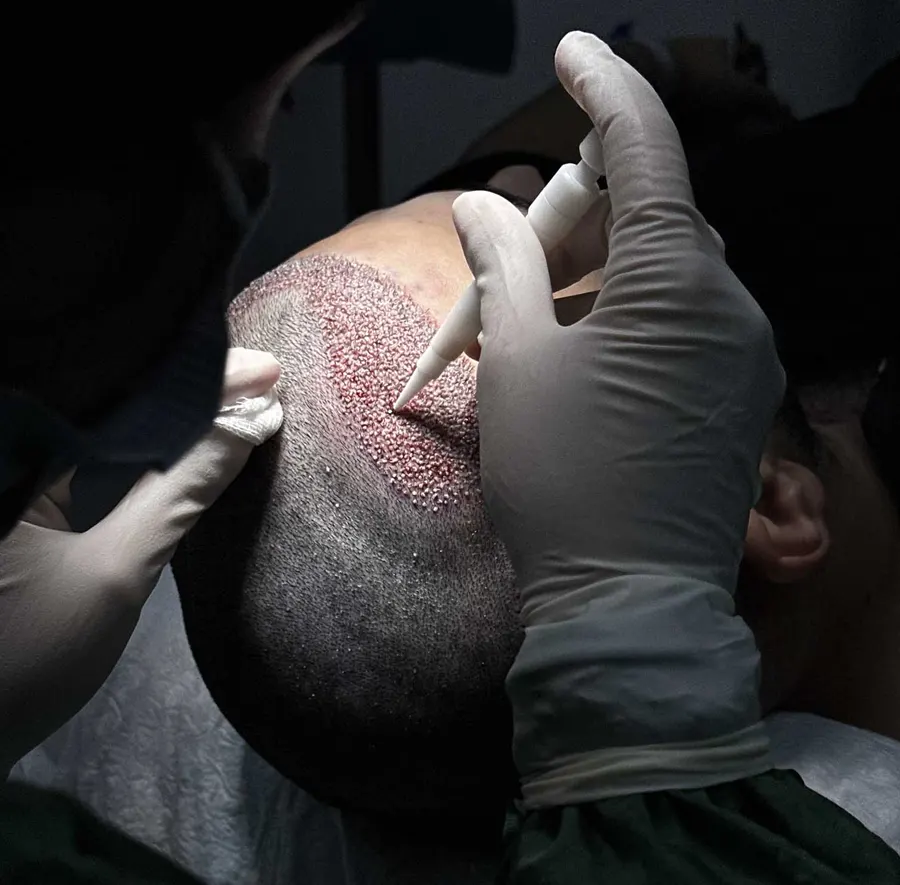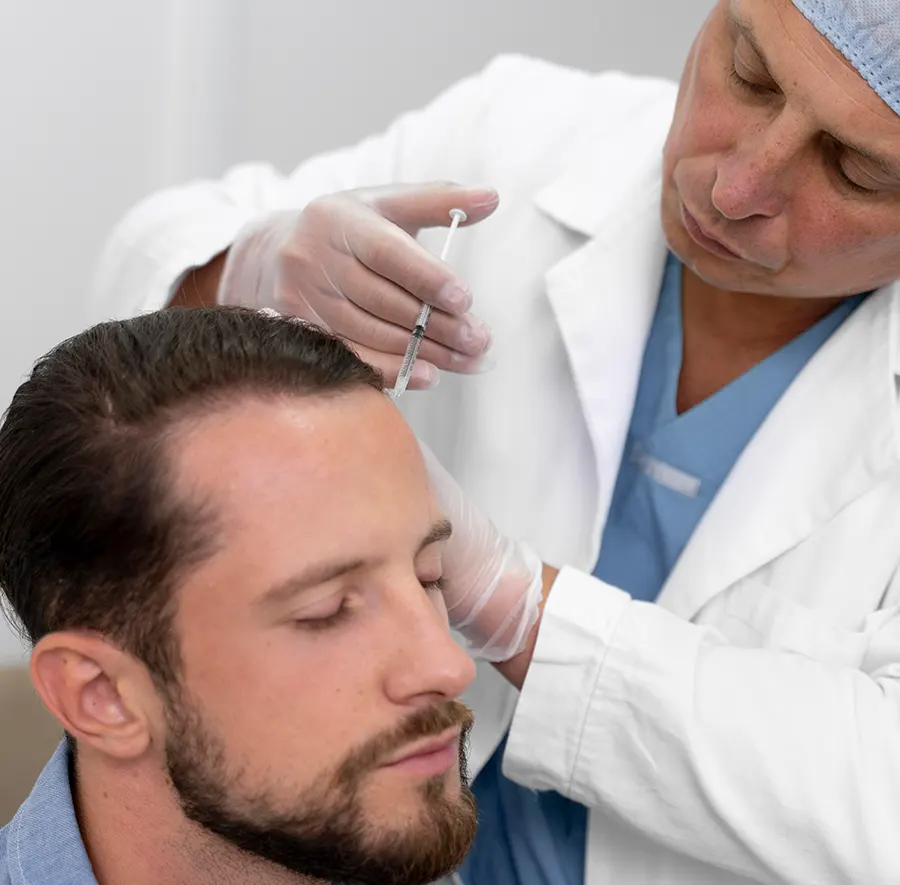Share on socials:
What to Expect After Hair Transplant Surgery
Hair transplant surgery can be a transformative experience, offering renewed confidence and a fuller head of hair. However, understanding the recovery process is crucial to ensure optimal results. This guide provides a detailed overview of what to expect post-surgery, tailored for our patients, with insights from KERA.

Immediate Post-Surgery (Days 0–3)
After the procedure, it’s normal to experience:
- Swelling and Redness: Particularly around the forehead and eyes.
- Mild Pain or Discomfort: Manageable with prescribed painkillers.
- Scab Formation: Small scabs may form around the transplanted follicles.
Care Instructions:
- Sleeping Position: Keep your head elevated at a 45-degree angle to reduce swelling.
- Avoid Touching the Scalp: Refrain from scratching or rubbing the transplanted area.
- Medications: Take antibiotics and anti-inflammatory drugs as prescribed.
First Week: Healing and Crusting
During this period:
- Scab Formation Continues: Scabs become more prominent.
- Itching Sensation: A sign of healing, but avoid scratching.
Care Instructions:
- Gentle Washing: Begin washing your hair with a mild, sulfate-free shampoo as advised by your surgeon.
- Avoid Direct Sunlight: Protect your scalp from sun exposure.
- No Physical Exertion: Avoid strenuous activities to prevent sweating.
Weeks 2–4: Shedding Phase (Shock Loss)
This phase may be concerning but is entirely normal:
- Hair Shedding: Transplanted hairs may fall out.
- Follicles Remain Intact: The roots stay embedded and will regrow.
Care Instructions:
- Continue Gentle Washing: Maintain scalp hygiene.
- Avoid Hair Styling Products: Refrain from using gels or sprays.
- Stay Patient: Understand that this is a temporary phase.
Months 1–3: Dormant Stage
In this period:
- Minimal Visible Growth: Hair follicles are in a resting phase.
- Possible Redness or Numbness: May persist but will gradually subside.
Care Instructions:
- Avoid Hair Treatments: No coloring or chemical treatments.
- Protect Scalp: Continue shielding from sun and dust.
- Regular Follow-ups: Attend scheduled appointments with your surgeon.
Months 4–6: Initial Hair Growth
Exciting changes begin:
- New Hair Emergence: Fine, thin hairs start to appear.
- Improved Density: Gradual increase in hair volume.
Care Instructions:
- Gentle Hair Care: Use mild shampoos and avoid harsh brushing.
- Balanced Diet: Ensure adequate protein and nutrient intake.
- Avoid Heat Styling: Refrain from using hair dryers or straighteners.
Months 6–12: Major Growth Phase
Significant improvements are noticeable:
- Thicker Hair: Hairs become denser and stronger.
- Natural Appearance: Hairline looks more natural and fuller.
Care Instructions:
- Regular Trimming: Maintain hair shape and health.
- Continue Protective Measures: Shield hair from harsh environmental factors.
- Consult Before Treatments: Seek advice before any hair coloring or treatments.
Months 12–18: Final Results
By this stage:
- Full Hair Growth: Most patients see complete results.
- Stable Hair Pattern: Hair growth stabilizes and maintains its pattern.
Care Instructions:
- Normal Hair Care Routine: Resume regular hair care practices.
- Periodic Check-ups: Schedule annual visits to monitor hair health.
- Healthy Lifestyle: Maintain a balanced diet and avoid stress.

Post-Operative Care Tips
- Avoid Smoking and Alcohol: These can hinder the healing process.
- Stay Hydrated: Drink plenty of water to support recovery.
- Limit Sun Exposure: Wear a hat or use sunscreen to protect the scalp.
- Limit Sun Exposure: Wear a hat or use sunscreen to protect the scalp.
Lifestyle Adjustments for Optimal Recovery
- Balanced Diet: Incorporate foods rich in vitamins and minerals.
- Regular Exercise: Engage in light physical activities to improve blood circulation.
- Stress Management: Practice relaxation techniques like meditation or yoga.
Common Side Effects and Management
- Swelling: Apply cold compresses and keep the head elevated.
- Itching: Use prescribed lotions or shampoos to alleviate discomfort.
- Numbness: Usually temporary and resolves over time.
Conclusion
Undergoing a hair transplant is a significant decision that can positively impact your self-esteem and appearance. By understanding the recovery process and adhering to post-operative care instructions, you can achieve the best possible results. KERA offers expert guidance and advanced techniques to support you throughout your hair restoration journey.
Take the First Step Today!
Don’t let hair loss define you. Whether you’re looking to restore your hairline, achieve fuller density, or regain confidence, KERA is here to help. Our expert team is dedicated to providing cutting-edge hair restoration solutions tailored to your needs.
For Those Inspired by Our Mission, Here’s How You Can Stay Connected and Support Us
Follow us on Instagram (@keratrichology) to stay updated on the latest advancements in hair restoration, success stories, and expert tips. Help us spread awareness about the importance of early intervention and advanced treatments like DHI and PRP therapy.
By sharing your journey and educating others, you contribute to breaking the stigma around hair loss and encouraging people to take action. Let’s work together to inspire confidence and redefine hair restoration—one transformation at a time!
